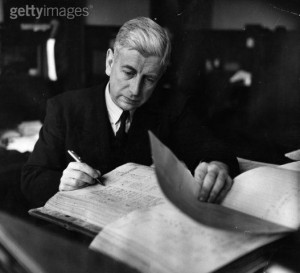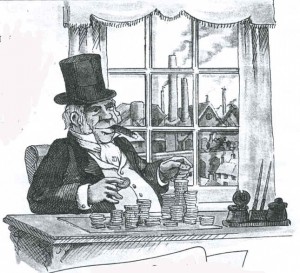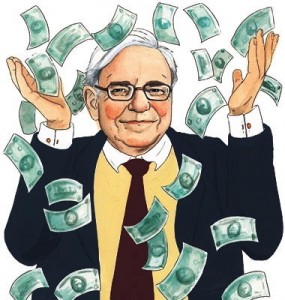Economic Cycles move Up and Down. We are now in a Down-state, a Recession. To stimulate consumers the Central Banks lower the interest and are pumping a tremendous amount of money into the economy.
Pumping money generates inflation and when inflation happens prices start to rise again. What the economist wants to avoid is deflation.
When prices rise people will buy goods and invest money. When the prices go up you can make a profit. When prices rise you have to buy the goods on the short term because they will be much more expensive in the future. When consumers believe the economy will contract they will start to save money to cope with the problems they believe they will encounter in the future. They will also postpone the buying of (luxury) goods. When they postpone producers will lower their prices and when prices are lowered other prices will be lowered. This is called Deflation and Economists are terribly afraid Deflation will happen.
A state of contraction is just like a state of expansion highly related to Expectations and Expectations are a Self-Fulfilling Prophesy. If the self-fulfilling prophesy of a down-fall is not broken the economy will shrink until eternity. To motivate consumers to believe in an Expanding Economy Economists tell scientific fairy-tales hoping people will start to believe things are going the right way again.
Social scientists know for a long time that the majority of the people are not rational at all. Humans act on impulse and explain their behavior later. Humans believe others who believe others who believe others. Most of the things that are happening in the Economy are very complex and we need a simple explanation of a trusted expert. At this moment there is one thing everybody believes. Things are going in the wrong direction and One Thing is for Sure.
Bad news travel very fast.
The current state of technology has speeded up the transport of bad news to almost the speed of light. The contraction of the current economy moves much faster than the comparable contraction during the Great Depression.
The economy is controlled by two variables, Production and Consumption.
In a balanced economy the two variables are voided. The consumer destroys (consumes, eats) the products of the producer. The destruction of the product starts a new production-cycle. When the production is not voided producers have to create an inventory and take stock or speed up production. Producers don’t like to take stock. Stock costs a lot of Money.
Producers are just like Consumers highly controlled by their Expectation of the Future. The big difference between the two is the reaction-time. Consumers are able to Act on Impulse. It takes a lot of time and coordination to produce. Producers have to control their impulsive emotions but to sell their products they have to stimulate the impulses of their customers.
In the current economy the time between production and destruction is extremely shortened. To keep the customer satisfied new versions of products are produced almost on-demand (on impulse). To organize a demand-driven production-line the producer needs highly advanced logistic systems. One of the most important concepts of logistics is to optimize the Inventory. Inventory costs money and space. To produce a product the chains of suppliers are heavily integrated.
Nobody is taking stock and one disturbance in the production chain causes a disturbance in the complete chain. When the impulses of the consumers are suddenly stopped a complete chain slows down and production has to stop.
When the Banks are not able to finance a slowdown of the supply-chain the production has to stop even faster. Again the effect of bad news has a huge and fast impact on every producer in the world. At this moment all the interconnected wordwide supply-chains are collapsing
We are living in a time where negative impacts propagate with the Speed of Light. The political institutions are unable to react to the speed of change that is now changing the world in an instant.
People remember negative impacts much better than positive impacts. The expectation of the Human is constructed to avoid big trouble. The constant sequence of bad news lowers the trust in almost everything that was trusted before.
At this moment Advisors, Bankers, Politicians, the Stock exchange, the Banking System, the Political system, the Medical System, Pension Funds, Insurers, the World Economy, the Climate and much more are not Trusted anymore. Everything is interpreted out of a negative perspective. Not only the economy is contracting but also the trust in the now and the future is contracting. Not only the Economy is in a Depression, many people are Depressed.
Production and Consumption are two important variables but there are really five variables at stake.
The cycle of Expansion and Contraction is balanced by two other variable called Spirit and Soul. Soul is related to the Human Emotions. Spirit is related to Human Creativity. The Four variables move around a Center and this Center is moving around other Centers.
Spirit is the Creator of New Ideas. Ideas want to move Down. They want to be realized on Earth. It is very difficult to determine these ideas because Old Ideas want to be Replicated all the time. Old Ideas have to be destroyed to make place for the New ones. The only way to do this is to enforce Stress on the old replication-system. It is very clear that this is happening at this moment. The old solutions don’t work anymore.
Soul contains the Human Potential and this potential is basically unlimited. When the Soul is Stressed it Explodes and new Opportunities become visible. There are two types of Stress. The Stress to create something New, the Stress of the Artist who is desperately trying to Express something that is there but cannot be Grasped. The other type of Stress is caused by the constant pressure of something that is forcing the Human to do what he really don’t wants to do or is not capable of doing. Let us call this type of stress, Negative stress.
Soul and Spirit are connected to the Destructor and the Controller.
When the Negative Stressed Emotions connect to The Destroyer of the Senses the Human becomes Violent. Sadly enough the Destructive force of a World Wide War will certainly generate an Up-state of the Economy.
When the Negative Stressed Emotions connect to the Expectations of the Controller it will generate Fear. Fear is the Destructor of the Senses. It narrows the view of the Human and produces the simple insight of the Common Enemy. They (not we) are the cause of all evil. A long time ago the Jews were the scapegoat. Recently Islamic Terrorists were the most important enemy. At this moment the “Greedy Bankers”, the Capitalists are the cause of the big economic crisis. If we don’t watch out we are moving into a new Struggle of the Classes.
When people are Afraid they simply stop moving. They wait and see and start to look for protection. In this case Big Brother is always there to help them. Extreme fear generates the need for all kinds of weapons to prevent war and to stop or even destroy the Agressive Humans. The Stressed Emotions create Enemies, Protectors, Weapons and finally the perfect reason to Fight a War or start a Revolution. If we don’t watch out a Huge Violent Conflict is unavoidable.
When the Emotions connect to Spirit, Spirit will generate an Insight. When this Insight has appeared Spirit will Transform the Soul and the Human will be lifted to another Center, a new Frame of Reference, a new View on the outside World. In this case Spirit gives the Expectation Hope, a view on a Bright and Exciting Future. The Creative Spirit is the Powerful Force behind Enthusiasm and Motivation.
We are living in an Illusion. Money is an illusion, the Economy is an Illusion, The Banking System is an Illusion, and the Contraction of the Economy is an Illusion. If we keep on believing this Illusion, the Economy, will slowdown, until it finally stops. At that time we have to cooperate to survive.
We See what we want to see and when we See a Contraction, the Contraction will happen. Our Expectation creates the world it wants to see and when the Expectation is without Hope, the outside world becomes Hopeless.
We, the Humans, are perfectly capable to create a completely balanced economy if we listen to the other, exchange ideas, cooperate and start to implement the ideas. We will always make mistakes but mistakes generate new ideas and the cycle of Innovation will start again.
LINKS

 The Amount of Trust you are able to give to an other is based on your experience with others. During his life a human develops a Trust-Pattern.
The Amount of Trust you are able to give to an other is based on your experience with others. During his life a human develops a Trust-Pattern. The level of Communion and Agency changes with Age. A child starts its life with a high level of Communion. It is highly dependent on his parents.
The level of Communion and Agency changes with Age. A child starts its life with a high level of Communion. It is highly dependent on his parents. The first stage (Childhood) ends when the Down path of Communion crosses the Up path of Agency.
The first stage (Childhood) ends when the Down path of Communion crosses the Up path of Agency. Some people experience a so called Mid-Life-Crisis.
Some people experience a so called Mid-Life-Crisis. You have to admit that gambling is very exiting when you discover a Way to Gamble and Never Lose called
You have to admit that gambling is very exiting when you discover a Way to Gamble and Never Lose called 